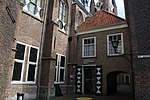Menschen Vereeniging Wolbodo
Delft University of TechnologyStudent societies in the Netherlands
The Mensenvereniging Wolbodo was founded in 1959 as the PSK (Parochiele Studenten Kring) by 17 students, who were Catholic, but did not want to join the Catholic student society Virgiel. In 1960 the name was changed to Sanctus Wolbodo or in Dutch "Sint Wolbodo", referring both to the saint who supposedly is the patron saint of students and to its Catholic nature.
Excerpt from the Wikipedia article Menschen Vereeniging Wolbodo (License: CC BY-SA 3.0, Authors).Menschen Vereeniging Wolbodo
Verwersdijk, Delft
Geographical coordinates (GPS) Address Nearby Places Show on map
Geographical coordinates (GPS)
| Latitude | Longitude |
|---|---|
| N 52.014824 ° | E 4.35751 ° |
Address
Verwersdijk 100
2611 NK Delft
South Holland, Netherlands
Open on Google Maps











